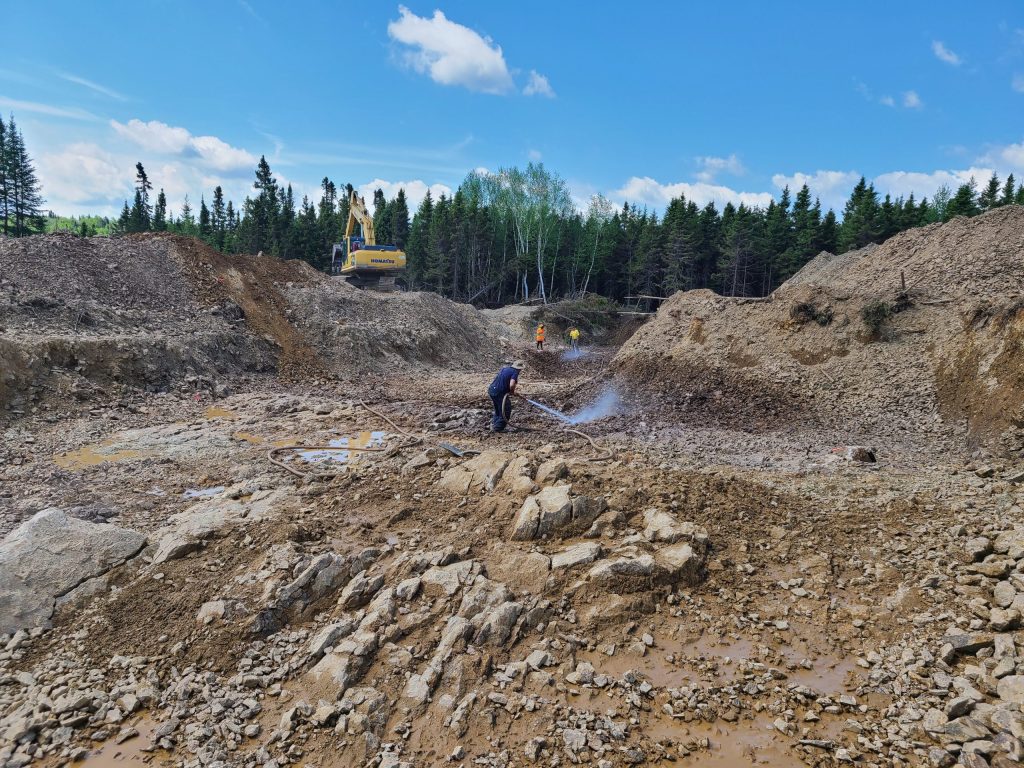Puma Exploration drills 12.03 g/t gold over 1.50 metres at Lynx gold zone, New Brunswick

Puma Exploration Inc. [PUMA-TSXV; PUMXF-OTCQB] reported up to 12.03 g/t gold over 1.50 metres in short (only 6 to 18-metres depth) HQ holes drilled last fall at the Lynx Gold Zone (LGZ) on its Williams Brook Gold Project, New Brunswick. The holes were drilled as part of an expanded metallurgical test announced on November 15, 2022. Static Acid Base Accounting and Total Sulphur testing also determined that the rock is non-acid-generating.
“These preliminary results from our expanded metallurgical test are very positive. Our gold-bearing quartz veins contain almost no sulphide or arsenic. Bulk sampling and potential mining would therefore be non-acid-generating. These results are significant as they enable us to further de-risk a potential mining operation at the Lynx Gold Zone,” noted Marcel Robillard, President and CEO.
The expanded metallurgical test was conducted to better define the gold mineralization found at surface (within the first 10 metres) at the Lynx Gold Zone, identify opportunities and potential challenges for gold recovery and help design the flowsheet (recipe) for processing the upcoming bulk sample. Test work on 300 kg of material collected on each of the 12 main quartz veins (3,300 kg total) at the LGZ is pending and will be released in the coming weeks.
Eight HQ holes, for a total of 102 metres, were drilled on three main quartz veins. Drilling targeted both high- and low-grade veins. Since the veins are known to dip, the holes were collared vertically to hit both the quartz veins at surface and the rhyolite underneath. Sampling of the quartz veins and the host rock was undertaken to corroborate the gold results of grab samples collected during surface exploration, verify their acid-generating potential, identify any negative implications of an open pit operation and provide valuable information for planning the upcoming bulk sample.
Consistent with results to date, the gold grades of the outcropping quartz veins assayed in the drill core reflect the gold grades from grab samples collected at surface as shown in holes WB22-114 with 25.20 g/t gold over 0.45 metres, WB22-118 with 19.65 g/t gold over 0.90 metres and WB22-117 with 7.99 over 0.90 metres.
Of note and as anticipated, gold mineralization was continuous from surface with assays returning 3.05 g/t gold over 6.00 metres (WB22-114), 1.23 g/t over 10.00 metres (WB22-117), and 2.52 g/t gold over 10.00 metres (WB22-118).
Acid mine drainage is a major environmental concern for mining operations. Mining companies must determine if weathering/oxidation of rock at their mine site produces acid and must devise and deploy a mitigation strategy to counteract acid production if present.
RPC tested 33 selected samples from the HQ holes drilled on the surface veins and on another two holes drilled in 2022 that intercepted the sediment hanging wall. All samples were subjected to static Acid Base Accounting (ABA) test work. None were found to be potentially acid-producing. In addition, the total sulphur content in all samples was either very low or below the detection limit of 0.005%. The ratio between Neutralizing Potential and Acid Production Potential along with the Total Sulphur results indicate that none of the 33 submitted samples were acid-producing.
Puma’s flagship Williams Brook Gold Project covers more than 50,000 hectares in Northern New Brunswick, an established and mining-friendly jurisdiction, near paved roads and with excellent infrastructure nearby. Since 2021, Puma has made four significant gold discoveries at Williams Brook, with gold mineralization hosted in quartz veins at surface.
An aggressive exploration program is planned for 2023, including a minimum of 6,000 metres of drilling and a 4,000-tonne bulk sample.
